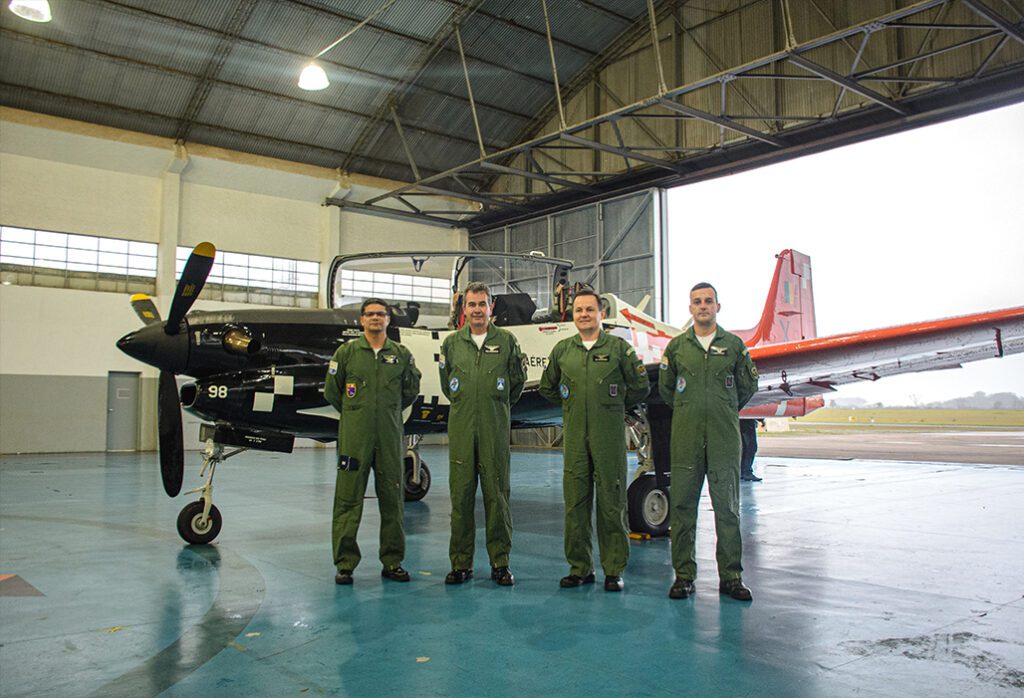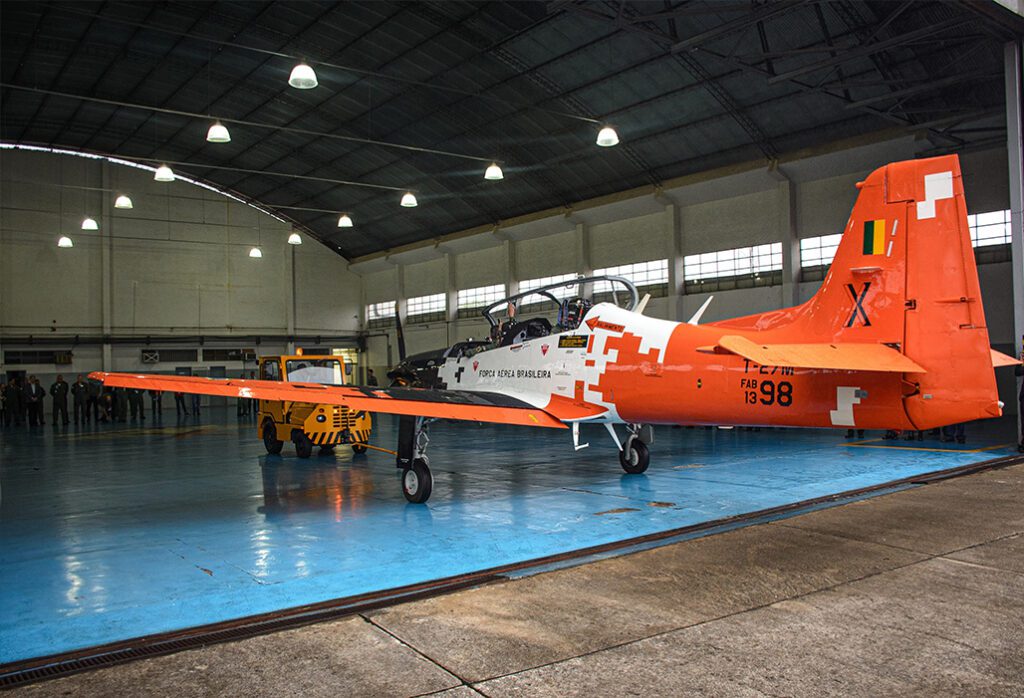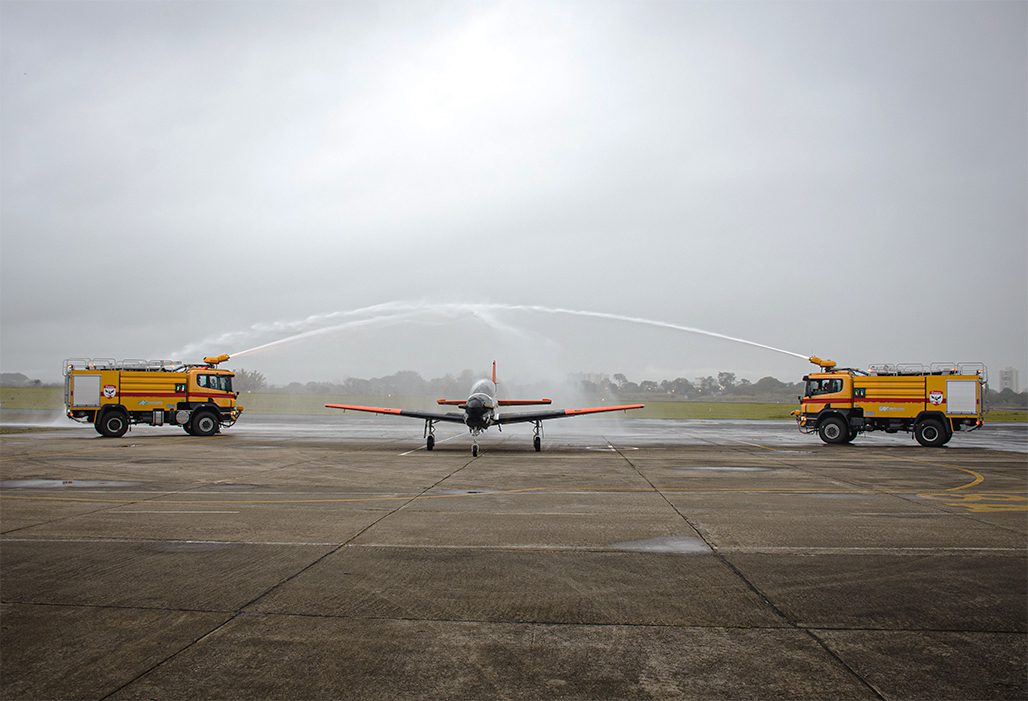The aircraft will be part of the fleet of the Flight Research and Test Institute (IPEV), located in São José dos Campos (SP)
Air Force Agency – Source: IPEV, by Captain Guilherme and Lieutenant Carolina Redlich
The Director General of the Department of Aerospace Science and Technology (DCTA), Air Lieutenant Brigadier Maurício Augusto Silveira de Medeiros, drove the modernized T-27 aircraft (T-27M) from Lagoa Santa (MG) to the Institute for Flight Research and Testing (IPEV), in São José dos Campos (SP), on September 15.
After landing, firemen from the Brazilian Airport Infrastructure Company (INFRAERO) welcomed the aircraft with the traditional baptism bath, which was attended by the Director of the Industrial Development and Coordination Institute (IFI), Aviator Colonel Luiz Marcelo Terdulino de Brito. Right after that, Lieutenant-Brigadier Medeiros passed to the hands of the IPEV Director, Aviator Colonel José Ricardo Silva Scarpari, the aircraft registration book, to the sound of songs intoned by the Music Band and in front of the Institute’s troop, composed by pilots, engineers, mechanics and technicians that participated in the project since the development of the modernized aircraft prototype.
Modernization of the T-27

The flight represented the delivery of the modernized aircraft, after a synergistic work carried out between IPEV and IFI, which began in 2020. The Organizations contribute to the T-27 modernization process with tests that evaluate the functionality, performance and reliability of the new systems, which are now presented in Glass Cockpit, based on aeronautical regulations and specialized techniques.
The Glass Cockpit concept has made possible, in this aircraft, flights and landing approaches based on satellite position and performance, that is, more direct and precise, besides sending and receiving information to air traffic control by means of the Automatic Dependent Air Surveillance System by Radio Broadcasting (ADS-B), which consists of a surveillance technology in which an aircraft determines its position via satellite navigation and transmits it periodically to ground stations, allowing it to be tracked by airspace control.
In this way, using the knowledge acquired at the Flight Test Training School (EFEV), IPEV professionals support the Brazilian Air Force’s (FAB) improvement, either by incorporating new capabilities or by improving existing ones, contributing to flight safety, as well as to the fulfillment of the institutional mission.
“This modernization of the T-27M contributes to raise the level of training of our cadets and highlights the high degree of competence of the members of the Lagoa Santa Aeronautical Material Park (PAMALS), IPEV and IFI. It also ratifies the excellence that we seek as an institution, providing state-of-the-art equipment, aligned with the demands of the 21st century. In a remarkable way, the T-27M returns to DCTA, where it was conceived and developed to achieve a prominent position as an instructional aircraft,” said the DCTA General Director.
In total, 42 aircraft are to be modernized, with the objective of introducing or changing technical and logistical features in the systems or materials in use in the Aeronautics, either to update them or to adjust their performance to the specific needs of today.
“At IPEV this magnificent machine also accompanied several generations of pilots and engineers who shared moments of tension and very high workload in the noble mission of forging the crews that today test the modern and recently arrived aircraft of the FAB, such as the Gripens and the KC-390. T-27M: Welcome to IPEV and DCTA. Know that our connection predates your first flight and that we still have many more hours to share together in the immensity of the sky, forecasting, training and testing the Air Force of tomorrow,” stated IPEV Director, Colonel Scarpari.

About the T-27M
The T-27 Tucano was born from a need of the FAB to replace the T-37C, which was used in advanced pilot training at the Air Force Academy (AFA). With an advanced design for the time it was developed and with unique characteristics for trainers of its type, the Tucano became a reference in performance and set a new standard. Not by chance, the aircraft was chosen to be used in demonstrations by the Smoke Squadron and, in a short time, became a Brazilian symbol that conquered the world.

Review: DCTA, Photos: Corporal J. Alves / DCTA – With information from the Air Force Agency
*** Translated by the DEFCONPress FYI Team ***
